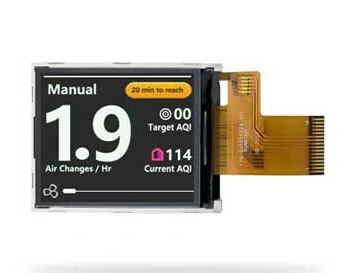Tft LCD screen two kinds of lamination technology, first of all, to understand the structure of tft display screen, can be divided into the outer protective glass, capacitive resistance touch screen and tft screen three parts. When these three components are integrated, they need to be laminated. Generally need to be laminated twice, only once between the protective glass and the touch screen, and another time between the tft screen and the touch screen.
According to the lamination, can be divided into full lamination and frame paste two kinds. tft screen using incomplete lamination technology, that is, framing. tft lcd of the following full lamination and frame paste two kinds of introduction respectively:.

1: tft screen framing sticker.
Framing is simply using double-sided tape to fix the touch screen on all four sides of the tft screen, the process is simple, low cost. However, due to the existence of air layer between the tft screen and the touch screen, light refraction after the display greatly reduced, becoming the biggest defect of the frame. Some even do not need glue, only need a snap can be fixed together in the three-layer structure. When these methods are used, the tft screen will fall off once it is impacted, and it is easy to get into the gray.
2: tft screen full lamination.
With the development of technology and people's criticism of incomplete lamination technology, full lamination technology came into being. Compared with frame lamination, full lamination has many advantages. Full lamination technology improves the interlayer gap of lamination, reduces the possibility of air and dust entering the tft screen, and keeps the tft screen clean. Full lamination technology eliminates the air between the tft screen, which can greatly reduce light reflection and light transmission loss, thus improving brightness, enhancing the display effect of the tft screen, and making the picture more transparent. Full lamination screens are also thinner than traditional screens. The touch screen uses optical adhesive to laminate the screen, the thickness only increased by 25 microns to 50 microns, which is 0.1 mm to 0.7 mm thinner than the ordinary laminated screen.
Overall, full lamination technology improves the gap between the lamination layers and the layers, reduces the possibility of air and dust entering the tft screen, and keeps the tft screen clean. Full lamination is better and more expensive than all others. If the product requirements are high, the protective glass and touch screen can be full lamination, tft screen, and the touch screen can also be full lamination.
sinocrystal is a professional customized LCD factory. The factory focuses on LCD customization and production. You can try to communicate with us about the project, and you can find the optimal TFT LCD screen customization solution.
The 8 inch displays might be affected and delay for an accident.
This is the project management of how sinocrystal handle your customized project relate to displays.
New iPhone 13 Series will use On-Cell OLED Displays. And it that will be launched in the second half of this year will be exclusively supplied by Samsung Display (SDC)
A complete guide to LCD display connection methods, including SPI, I2C, RGB, MIPI, LVDS interfaces and physical mounting options. Learn how to connect monochrome and TFT LCDs to your development board or product housing.
This week, we had the pleasure of hosting an esteemed international client at our LCD display manufacturing facility in Dongguan. Guided by our team, the client visited key production areas such as the fully automated COG bonding line, backlight assembly area, full lamination workshop, and final product aging test section. They highly appreciated our production capacity, strict quality control, and engineering expertise. This visit strengthened mutual trust and set the stage for future collabora
The ILI9881C is a high-performance a-Si TFT LCD single-chip driver developed by ILI Technology Corp. With its excellent display performance and flexible configuration options, this driver meets the modern display device requirements for high resolution and color accuracy. This article will detail the supported resolutions, interfaces, and power supply voltage of the ILI9881C.
The GC9307, a TFT LCD driver with QVGA resolution, has gained widespread use among LCD module manufacturers since its launch. Sinocrystal are excited to share a series of practical insights we have gathered from using the GC9307 driver.